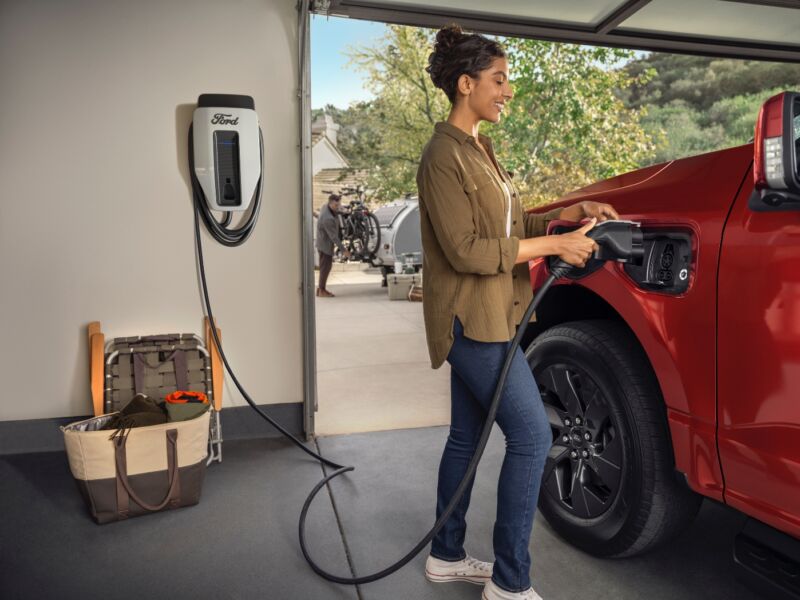A giant battery that happens to have wheels —
It’s only one truck and one thermostat, but it could be the start of a V2H wave.

Enlarge / It’s a hefty plug, but it has to be so that an F-150 Lightning can send power back to the home through an 80-amp Ford Charge Station Pro.
Ford
Modern EVs have some pretty huge batteries, but like their gas-powered counterparts, the main thing they do is sit in one place, unused. The Ford F-150 Lightning was built with two-way power in mind, and soon it might have a use outside emergency scenarios.
Ford and Resideo, a Honeywell Home thermostat brand, recently announced the EV-Home Power Partnership. It’s still in the testing phases, but it could help make EVs a more optimal purchase. Put simply, you could charge your EV when it’s cheap, and when temperatures or demand make grid power time-of-use expensive (or pulled from less renewable sources), you could use your truck’s battery to power the AC. That would also help with grid reliability, should enough people implement such a backup.
The F-150 Lightning already offers a whole-home backup power option, one that requires the professional installation of an 80-amp Ford Charge Station Pro and a home transfer switch to prevent problems when the grid switches back on. Having a smart thermostat allows for grid demand response, so the F-150 would be able to more actively use its vehicle-to-home (V2H) abilities.
It’s one vehicle and one thermostat, but it’s likely just the start. General Motors’ latest Ultium chargers, installed with its 2024 EVs, will also offer bi-directional home charging. The 2024 GM EVs scheduled to implement V2H are generally pretty hefty: the Chevrolet Silverado EV RST, GMC Sierra EV Denali Edition 1, Chevrolet Equinox EV, Cadillac Escalade IQ, and the comparatively smaller Cadillac Lyriq.
Ford and GM are also partnering with Pacific Gas and Electric (PG&E) to research bi-directional charging programs. Beyond a single vehicle powering a single home, there’s movement toward incorporating EVs into “V2G,” or vehicle-to-grid charging. V2G programs typically involve a utility, with an owner’s consent, using some of a car’s battery power to stabilize the grid during extreme heat events, making the grid more flexible. Roughly 100 V2G pilot programs were launched or being researched in late 2022 when California became interested in wide-scale implementation.
Ford’s FordPass app already allows F-150 Lightning owners to manage how much of their battery is made available during power outages and notifies them when a switchover is happening. Such an opt-in, limited option would likely be part of Ford and Resideo’s partnership. Still, there are many questions inherent to any kind of automated grid power, including those around battery degradation, privacy, and, of course, a new wrinkle on range anxiety.